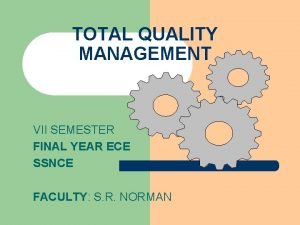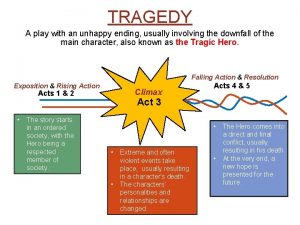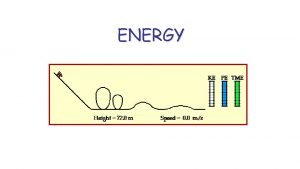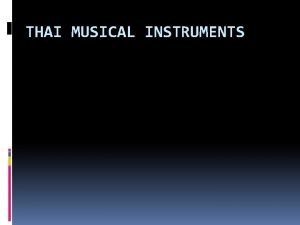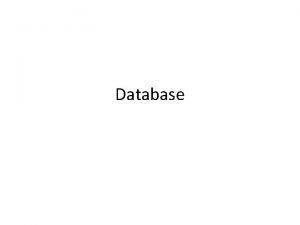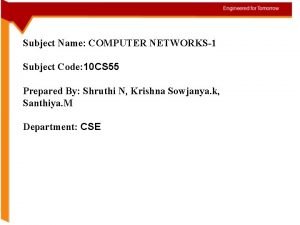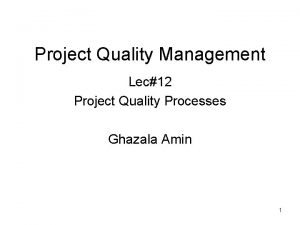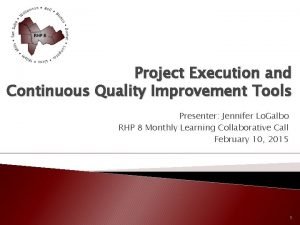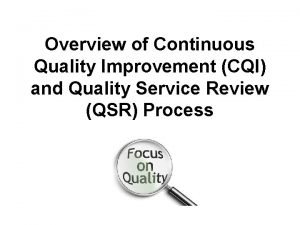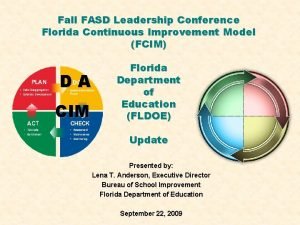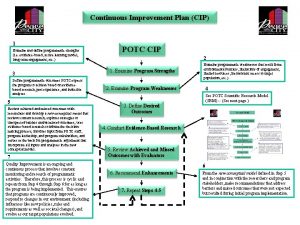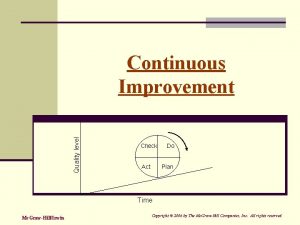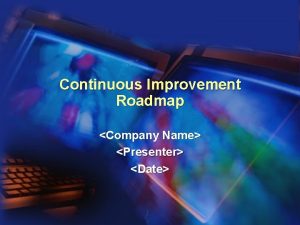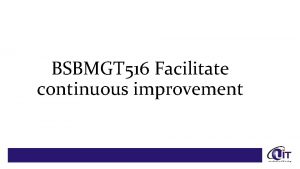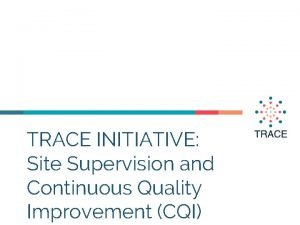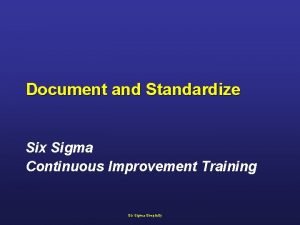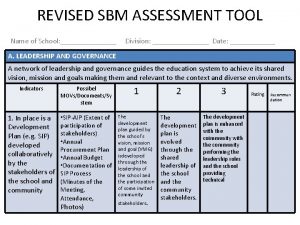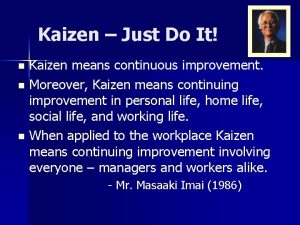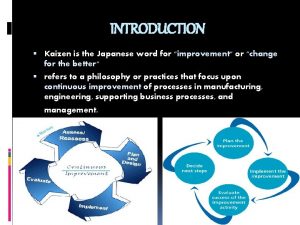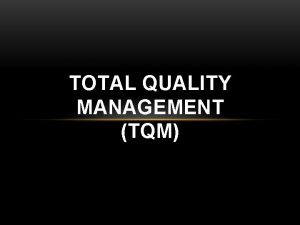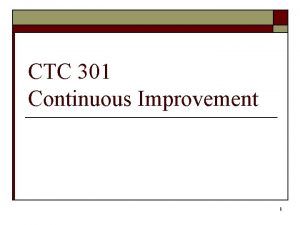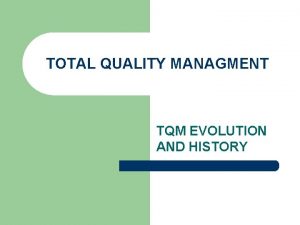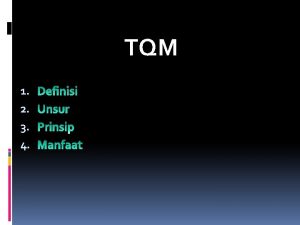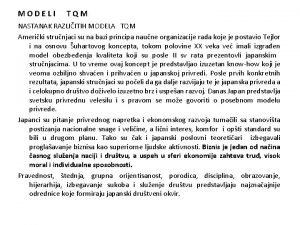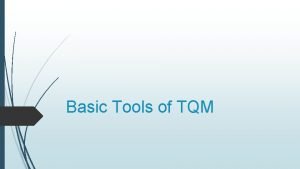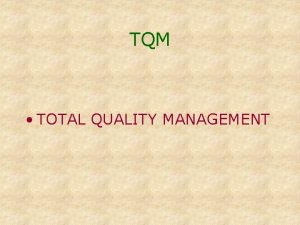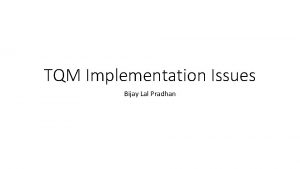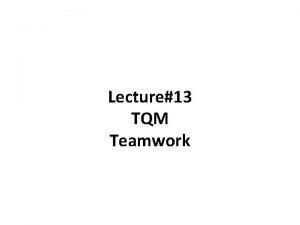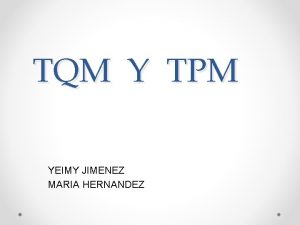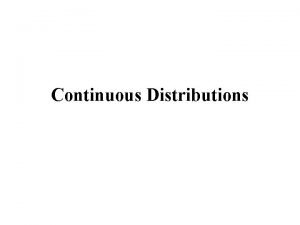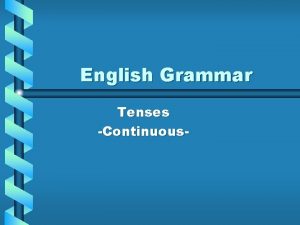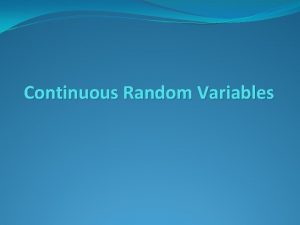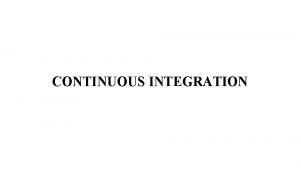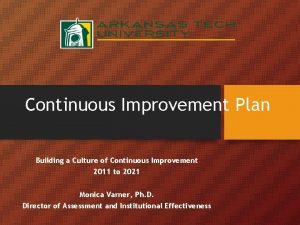Lecture 03 TQM Continuous Improvement Traditionally change for

































- Slides: 33

Lecture 03 TQM

Continuous Improvement • Traditionally, change for American managers involves large magnitudes, such as major organizational restructuring. • The Japanese, on the other hand, believe that the best and most lasting changes come from gradual improvements. • To use an analogy, they believe that it is better to take frequent small doses of medicine than to take one large dose. Continuous improvement, called kaizen by the Japanese, requires that the company continually strive to be better through learning and problem solving. • Because we can never achieve perfection, we must always evaluate our performance and take measures to improve it. • Now let’s look at two approaches that can help companies with continuous improvement: the plan –do– study – act (PDSA) cycle and benchmarking. 2

TABLE 5 -3: Concepts of the TQM Philosophy Concept Main Idea Customer focus Goal is to identify and meet customer needs. Continuous improvement A philosophy of never-ending improvement. Employee empowerment Employees are expected to seek out, identify, and correct quality problems. Use of quality tools Ongoing employee training in the use of quality tools. Product design Products need to be designed to meet customer expectations. Process management Quality should be built into the process; sources of quality problems should be identified and corrected. Managing supplier quality Quality concepts must extend to a company’s suppliers. 3

The Plan–Do–Study–Act Cycle • The plan–do–study–act (PDSA) cycle describes the activities a company needs to perform in order to incorporate continuous improvement in its operation. • This cycle, shown in Figure 5 -6 is also referred to as the Shewhart cycle or the Deming wheel. • The circular nature of this cycle shows that continuous improvement is a never-ending process. Let’s look at the specific steps in the cycle. 4

The Plan–Do–Study–Act Cycle – Plan • The first step in the PDSA cycle is to plan. Managers must evaluate the current process and make plans based on any problems they find. • They need to document all current procedures, collect data, and identify problems. • This information should then be studied and used to develop a plan for improvement as well as specific measures to evaluate performance. – Do • The next step in the cycle is implementing the plan (do). • During the implementation process managers should document all changes made and collect data for evaluation. 5

The Plan–Do–Study–Act Cycle – Study • The third step is to study the data collected in the previous phase. • The data are evaluated to see whether the plan is achieving the goals established in the plan phase. – Act • The last phase of the cycle is to act on the basis of the results of the first three phases. • The best way to accomplish this is to communicate the results to other members in the company and then implement the new procedure if it has been successful. • Note that this is a cycle; the next step is to plan again. • After we have acted, we need to continue evaluating the process, planning, and repeating the cycle again. 6

Benchmarking • Another way companies implement continuous improvement is by studying business practices of companies considered “best in class. ” • This is called benchmarking. • The ability to learn and study how others do things is an important part of continuous improvement. • The benchmark company does not have to be in the same business, as long as it excels at something that the company doing the study wishes to emulate. • For example, many companies have used Lands’ End to benchmark catalog distribution and order filling, because Lands’ End is considered a leader in this area. • Similarly, many companies have used American Express to benchmark conflict resolution. 7

Employee Empowerment • Part of the TQM philosophy is to empower all employees to seek out quality problems and correct them. • With the old concept of quality, employees were afraid to identify problems for fear that they would be reprimanded. • Often poor quality was passed on to someone else, in order to make it “someone else’s problem. ” • The new concept of quality, TQM, provides incentives for employees to identify quality problems. • Employees are rewarded for uncovering quality problems, not punished. 8

Employee Empowerment • In TQM, the role of employees is very different from what it was in traditional systems. • Workers are empowered to make decisions relative to quality in the production process. • They are considered a vital element of the effort to achieve high quality. • Their contributions are highly valued, and their suggestions are implemented. • In order to perform this function, employees are given continual and extensive training in quality measurement tools. 9

Employee Empowerment • To further stress the role of employees in quality, TQM differentiates between external and internal customers. • External customers are those that purchase the company’s goods and services. • Internal customers are employees of the organization who receive goods or services from others in the company. • For example, the packaging department of an organization is an internal customer of the assembly department. • Just as a defective item would not be passed to an external customer, a defective item should not be passed to an internal customer. 10

Team Approach • TQM stresses that quality is an organizational effort. • To facilitate the solving of quality problems, it places great emphasis on teamwork. • The use of teams is based on the old adage that “two heads are better than one. ” • Using techniques such as brainstorming, discussion, and quality control tools, teams work regularly to correct problems. • The contributions of teams are considered vital to the success of the company. • For this reason, companies set aside time in the workday for team meetings. 11

Team Approach • Teams vary in their degree of structure and formality, and different types of teams solve different types of problems. • One of the most common types of teams is the quality circle, a team of volunteer production employees and their supervisors whose purpose is to solve quality problems. • The circle is usually composed of eight to ten members, and decisions are made through group consensus. • The teams usually meet weekly during work hours in a place designated for this purpose. 12

Team Approach • They follow a preset process for analyzing and solving quality problems. • Open discussion is promoted, and criticism is not allowed. • Although the functioning of quality circles is friendly and casual, it is serious business. • Quality circles are not mere “gab sessions. ” • Rather, they do important work for the company and have been very successful in many firms. 13

Team Approach • The importance of exceptional quality is demonstrated by The Walt Disney Company in operating its theme parks. • The focus of the parks is customer satisfaction. • This is accomplished through meticulous attention to every detail, with particular focus on the role of employees in service delivery. • Employees are viewed as the most important organizational resource and great care is taken in employee hiring and training. 14

Team Approach • All employees are called “cast members, ” regardless of whether they are janitors or erformers. • Employees are extensively trained in customer service, communication, and quality awareness. • Continual monitoring of quality is considered important, and employees meet regularly in teams to evaluate their effectiveness. • All employees are shown how the quality of their individual jobs contributes to the success of the park. 15

Use of Quality Tools • You can see that TQM places a great deal of responsibility on all workers. • If employees are to identify and correct quality problems, they need proper training. • They need to understand how to assess quality by using a variety of quality control tools, how to interpret findings, and how to correct problems. • In this section we look at seven different quality tools. • These are often called the seven tools of quality control and are shown in Figure 5 -7. • They are easy to understand, yet extremely useful in identifying and analyzing quality problems. • Sometimes workers use only one tool at a time, but often a combination of tools is most helpful. 16

Cause-and-Effect Diagrams • Cause-and-effect diagrams are charts that identify potential causes for particular quality problems. • They are often called fishbone diagrams because they look like the bones of a fish. • A general cause-and-effect diagram is shown in Figure 5 -8. The “head” of the fish is the quality problem, such as damaged zippers on a garment or broken valves on a tire. • The diagram is drawn so that the “spine” of the fish connects the “head” to the possible cause of the problem. • These causes could be related to the machines, workers, measurement, suppliers, materials, and many other aspects of the production process. • Each of these possible causes can then have smaller “bones” that address specific issues that relate to each cause. For example, 17

Cause-and-Effect Diagrams • a problem with machines could be due to a need for adjustment, old equipment, or tooling problems. • Similarly, a problem with workers could be related to lack of training, poor supervision, or fatigue. • Cause-and-effect diagrams are problem-solving tools commonly used by quality control teams. • Specific causes of problems can be explored through brainstorming. • The development of a cause-and-effect diagram requires the team to think through all the possible causes of poor quality. 18

Flowcharts • A flowchart is a schematic diagram of the sequence of steps involved in an operation or process. • It provides a visual tool that is easy to use and understand. • By seeing the steps involved in an operation or process, everyone develops a clear picture of how the operation works and where problems could arise. 19

FIGURE 5 -7 The seven tools of quality control 1. Cause-and-Effect Diagram Suppliers Workers Machines Quality Problems Environment 2. Process Material Flowchart 20

FIGURE 5 -7 The seven tools of quality control 3. Checklist Defect Type 4. No. of Defects Total Broken zipper 3 Ripped material 7 Missing buttons 3 Faded color 2 Control Chart UCL LCL 21

FIGURE 5 -7 The seven tools of quality control 5. Scatter Diagram Y X 6. Pareto Chart % A B C D E 22

FIGURE 5 -7 The seven tools of quality control 7. Histogram Frequency A B C D E 23

Checklists • A checklist is a list of common defects and the number of observed occurrences of these defects. • It is a simple yet effective fact-finding tool that allows the worker to collect specific information regarding the defects observed. • The checklist in Figure 5 -7 shows four defects and the number of times they have been observed. • It is clear that the biggest problem is ripped material. • This means that the plant needs to focus on this specific problem—for example, by going to the source of supply or seeing whether the material rips during a particular production process. 24

Checklists • A checklist can also be used to focus on other dimensions, such as location or time. • For example, if a defect is being observed frequently, a checklist can be developed that measures the number of occurrences per shift, per machine, or per operator. • In this fashion we can isolate the location of the particular defect and then focus on correcting the problem. 25

Control Charts • Control charts are a very important quality control tool. • We will study the use of control charts at great length in the next chapter. • These charts are used to evaluate whether a process is operating within expectations relative to some measured value such as weight, width, or volume. • For example, we could measure the weight of a sack of flour, the width of a tire, or the volume of a bottle of soft drink. • When the production process is operating within expectations, we say that it is “in control. ” 26

Control Charts • To evaluate whether or not a process is in control, we regularly measure the variable of interest and plot it on a control chart. • The chart has a line down the center representing the average value of the variable we are measuring. • Above and below the center line are two lines, called the upper control limit (UCL) and the lower control limit (LCL). • As long as the observed values fall within the upper and lower control limits, the process is in control and there is no problem with quality. • When a measured observation falls outside of these limits, there is a problem. 27

Scatter Diagrams • Scatter diagrams are graphs that show two variables are related to one another. • They are particularly useful in detecting the amount of correlation, or the degree of linear relationship, between two variables. • For example, increased production speed and number of defects could be correlated positively; as production speed increases, so does the number of defects. • Two variables could also be correlated negatively, so that an increase in one of the variables is associated with a decrease in the other. • For example, increased worker training might be associated with a decrease in the number of defects observed. 28

Scatter Diagrams • The greater the degree of correlation, the more linear are the observations in the scatter diagram. • On the other hand, the more scattered the observations in the diagram, the less correlation exists between the variables. • Of course, other types of relationships can also be observed on a scatter diagram, such as an inverted. • This may be the case when one is observing the relationship between two variables such as oven temperature and number of defects, since temperatures below and above the ideal could lead to defects. 29

Pareto Analysis • Pareto analysis is a technique used to identify quality problems based on their degree of importance. • The logic behind Pareto analysis is that only a few quality problems are important, whereas many others are not critical. • The technique was named after Vilfredo Pareto, a nineteenthcentury Italian economist who determined that only a small percentage of people controlled most of the wealth. • This concept has often been called the 80– 20 rule and has been extended to many areas. • In quality management the logic behind Pareto’s principle is that most quality problems are a result of only a few causes. • The trick is to identify these causes. 30

Pareto Analysis • One way to use Pareto analysis is to develop a chart that ranks the causes of poor quality in decreasing order based on the percentage of defects each has caused. • For example, a tally can be made of the number of defects that result from different causes, such as operator error, defective parts, or inaccurate machine calibrations. • Percentages of defects can be computed from the tally and placed in a chart like those shown in Figure 5 -7. • We generally tend to find that a few causes account for most of the defects. 31

Histograms • A histogram is a chart that shows the frequency distribution of observed values of a variable. • We can see from the plot what type of distribution a particular variable displays, such as whether it has a normal distribution and whether the distribution is symmetrical. 32

Histograms • In the food service industry the use of quality control tools is important in identifying quality problems. • Grocery store chains, such as Kroger and Meijer, must record and monitor the quality of incoming produce, such as tomatoes and lettuce. • Quality tools can be used to evaluate the acceptability of product quality and to monitor product quality from individual suppliers. • They can also be used to evaluate causes of quality problems, such as long transit time or poor refrigeration. • Similarly, restaurants use quality control tools to evaluate and monitor the quality of delivered goods, such as meats, produce, or baked goods. 33
 Four improvement strategies in tqm
Four improvement strategies in tqm 01:640:244 lecture notes - lecture 15: plat, idah, farad
01:640:244 lecture notes - lecture 15: plat, idah, farad Past future continuous
Past future continuous Present simple, past simple, future simple
Present simple, past simple, future simple Referred to a play with an unhappy ending.
Referred to a play with an unhappy ending. Chapter 29 light cured gels
Chapter 29 light cured gels Defnition of energy
Defnition of energy Nokan instrument
Nokan instrument Thailand traditional instruments
Thailand traditional instruments Traditionally, composed of a collection of file folders.
Traditionally, composed of a collection of file folders. Computer subject code
Computer subject code Traditionally the internet checksum is
Traditionally the internet checksum is Jrotc continuous improvement plan
Jrotc continuous improvement plan Continuous improvement
Continuous improvement Continuous quality improvement plan example
Continuous quality improvement plan example Define continuous quality improvement
Define continuous quality improvement Florida continuous improvement model
Florida continuous improvement model Corrective action board
Corrective action board Cip 1
Cip 1 Continuous improvement check sheet
Continuous improvement check sheet Itil 7 step improvement process
Itil 7 step improvement process Continuous improvement roadmap
Continuous improvement roadmap Bsbmgt516
Bsbmgt516 Continuous quality improvement program planning worksheet
Continuous quality improvement program planning worksheet Continuous improvement documentation
Continuous improvement documentation Sbm movs
Sbm movs Just do it kaizen
Just do it kaizen Objectives of orientation programme for teachers
Objectives of orientation programme for teachers Japanese word for improvement
Japanese word for improvement Kontinuitetshantering
Kontinuitetshantering Novell typiska drag
Novell typiska drag Nationell inriktning för artificiell intelligens
Nationell inriktning för artificiell intelligens Ekologiskt fotavtryck
Ekologiskt fotavtryck Shingelfrisyren
Shingelfrisyren
